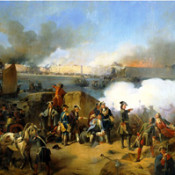
Russian forces have occupied Noteborg fortress
Shlisselburg fortress (Oreshek – The Nut) was founded by a Novgorod prince Yuri Danilovitch, a grandson of Alexander Nevsky in 1323 on Orekhovy island at the Neva river head as an outpost at the border with Sweden.
In 14-17th centuries it had withstood numerous fierce sieges. In 1612 after the nine months’ siege the fortress fell and had remained under the rule of Sweden for 90 years. It was then that it received the name Noteborg (The Nut city).
During the Northern war of 1700-1721 Peter I decided to take hold of the Neva river by capturing Noteborg on Ladoga and the Nyenshantz fortress on the Gulf of Finland.
The siege of Noteburg began on September 27 (October 8) 1702 under the personal supervision of Peter I. The garrison of the fortress numbered 450 men holding 148 guns. After 10 days of bombardment of the fortress from 52 coast and ship guns, the soldiers of Preobrazhensky and Semenovsky regiments joined by volunteers from other Peter’s regiments have rowed across the river to the island under the gunfire and started to besiege the fortress’ walls.
On October 11 (22) 1702, after 13 hours of stubborn struggle the Sweden garrison surrendered. On October 12 (23) the Russian ships entered the Neva river. Informing about the victory Peter I wrote: ‘The county’s fortress that had been in unjust hands for 90 years is returned… it is true that this nut was very hard but thanks to God it was successfully cracked. Out artillery has worked brilliantly’.
Peter I renamed the fortress from Noteborg to Shlisselburg that in German means ‘key-town’ as a symbol of the fact that this fortress is the pass to the Baltic Sea. In 18-19th centuries the fortress of Shlisselburg won the fame of the Russian Bastille. There were kept the disgraced members of tsar’s family, aspirants for the throne, political criminals and terrorists. From 1907 the fortress had become the central convict prison.
In August of 1928 a museum opened in the fortress of Shlisselburg – a branch of October revolution Museum. During the Great Patriotic War the defenders of the fortress had been defending it for almost 500 days providing the access to Ladoga and preventing the isolation of Leningrad from the Land. Artillery fire had destroyed many of the monuments of Shlisselburg some of them had become ruins.
From 1965 the fortress of Shlisselburg has become a branch of the State museum of Leningrad’s history.
Lit.: Кирпичников А. Н., Сапков В. М. Крепость Орешек. Л., 1979; Крепость Орешек [Электронный ресурс] // Государственный музей истории Санкт-Петербурга. Б. д. URL: http://www.spbmuseum.ru/themuseum/museum_complex/oreshek_fortress/; Крепость Орешек [Электронный ресурс] // Малые города России. 1999-2005. URL: http://www.towns.ru/other/oreshek.html.
Based on the Presidential Library’s materials:
Great Northern War (1700–1721) // Peter I (1672–1725): [digital collection];
Legislative acts of Peter I. Great Northern War (1700–1721) // State Authority: [digital collection].

